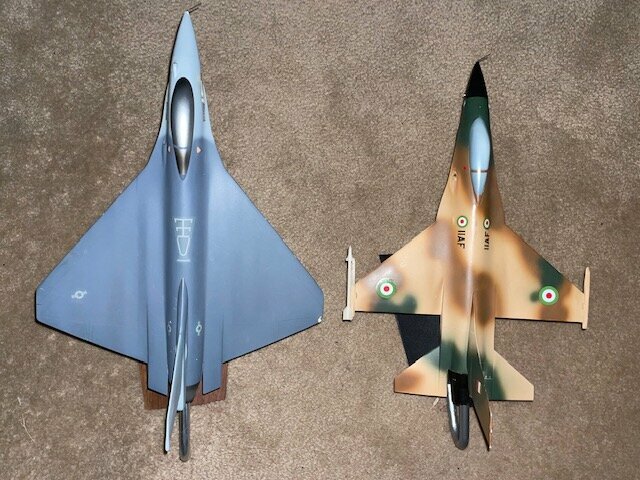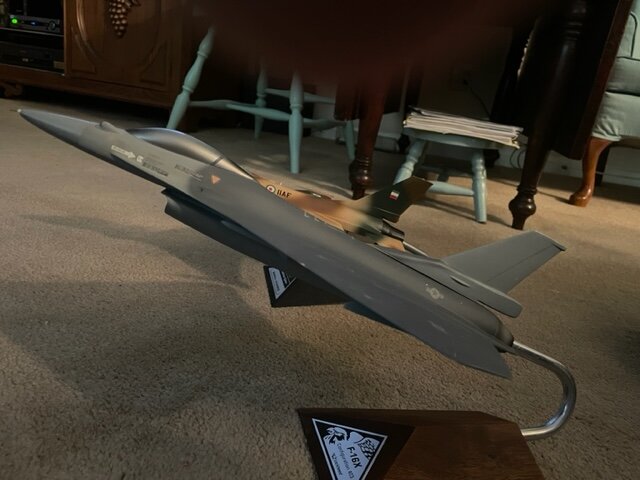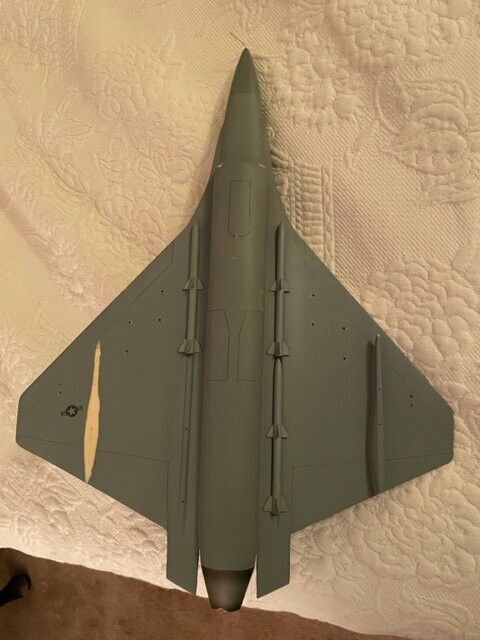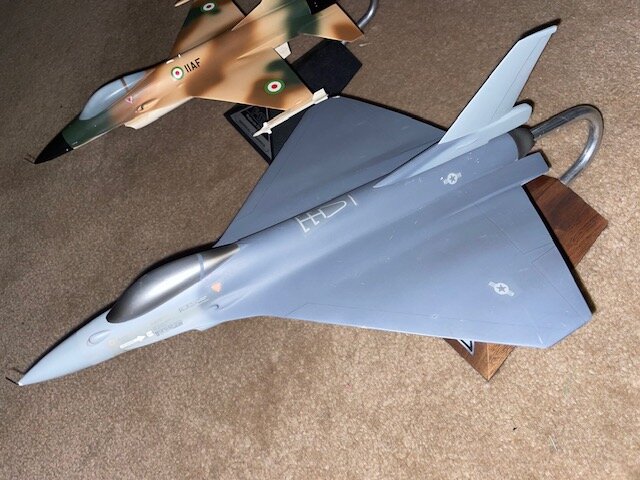BlackBat242
OK, I changed my personal text ;)
- Joined
- 10 April 2013
- Messages
- 1,482
- Reaction score
- 4,301
They have some excellent shots in their feed.
Here some new pictures of the F-16XL, posted by Fighterman_FFRC at twitter :
View: https://twitter.com/Fighterman_FFRC/status/1619583184680939520?t=mM9q3fPsb36hCjJxg_7xkA&s=19
View: https://twitter.com/Fighterman_FFRC/status/1623831311981940736?t=1gF3V2a05qcJt489sqcbqA&s=19
In the early 80s, the designers of the 100-3 brigade repeatedly proposed to consider the SСAMP scheme in relation to the Su-27, but at that time it was not possible to do this because of the heavy load on the main topic. We were able to actually carry out such a study only in 1983. On behalf of O.S. Samoilovich, I was engaged in shaping the appearance of such an aircraft, which received the designation 10E." From the point of view of aerodynamics, the issue of forming an area graph close to ideal was successfully solved in this layout. Taking into account what was known about the F-16XL, this allowed us to hope for a significant improvement in flight performance, for example, flight range at subsonic and supersonic speeds, increased payload mass, and so on. When we reported our research to M.P. Simonov, he approved the direction of work and suggested considering a new option, with an upper arrangement of air intakes and more powerful Kolesov engines."
From the original aircraft, made according to the normal aerodynamic scheme, they switched to the "tailless" scheme with a "double delta" wing, with increased sweep angles of the leading edge and a reduced relative thickness of the profile. On the "10E", the configuration of the influx changed significantly, the shape of the air intakes, tail beams and chassis fairings was modified, mechanization appeared on the trailing edge of the tail beams. The use of a thinner swept wing was supposed to provide a reduction in drag at supersonic. A positive effect was also expected from the use of a new influx with increased coupling radii with the fuselage, since at the same time the gap in the graph of cross-sectional areas disappeared. According to calculations, all these measures in the complex provided a 20% reduction in wave resistance (!), even with an increase in the area of the mid-section of the aircraft by 15%. The wing of the increased area increased the load-bearing characteristics, the specific load on the wing decreased. At the same time, the increase in internal volumes made it possible to improve the placement of on-board equipment and increase the maximum internal fuel reserve by more than one and a half times.
In general the F-16XL had MUCH better flight characteristics than the standard F-16.
View attachment 693268
Of course. Results were mixed. XL generally had a better initial pitch rate, so could make the first turn into the target better. But, like deltas in general, it had lower sustained g capability. XL had 9g turn capability, same as F-16, but had higher rolling g capability, 7.2 vs 6 for F-16. It also had a flight control refinement which allowed the pilot to command a max roll at any g level, all the way to 9g. Roll rate was automatically reduced above 7.2g. On the F-16, max roll commands are allowed up to 6g only. The XL had a higher maximum speed than the F-16, but slower acceleration.
“The XL wing, like any delta wing, has a flatter lift coefficient curve than a wing with lower sweep angle. So for a given wing area, it takes more angle of attack to produce a given amount of lift. More AoA in itself is not a bad thing, but along with more AoA comes more drag increase. Deltas also tend to have higher takeoff landing speeds (no flaps). Canards can be added to help reduce some of the disadvantages. Deltas are best suited for high speed cruise (Concorde, SR-71, B-70, B-58) and interceptors (F-102, F-106).
The top speed of XL was higher than the F-16, but by how much, we'll never know. At high altitude, high mach the climb rate and acceleration was excellent, but airplane was limited to 2.05 mach since analysis and testing had not been done to support higher speeds.”
Someone pointed out the graphs are slightly different in another topic, nobody seems to be sure where you got that. I guess that’s the price for being the man. John is a wealth for information on the XL, he was very helpful when I asked about other projects he worked on.I thought for sure that report is where I originally got the graphs from.
JohnWill's posts in that thread are interesting:
"geogen,
With the XL fuselage stretch, bigger wing, more fuel, more weapons, etc, the gross weight of the XL reached as much as 48,000 lb. That really pushed the capability of the landing gear to handle all the extra weight. We used some Isreali F-16 gear components to increase capability, but any production XL would have required a full redesign of the gear and fuselage substructure. Add in CFT and the problems are compounded. Of course, they could be made to work, but there is a point beyond which little is gained by adding more fuel and weapons.
ViperDude,
I was structural flight test leader for GD on XL at Eddy in 1982, so maybe I ran into you then. I did the same job on AFTI at NASA Dryden in '84 and '85.
My memory of the J-79 differs from yours. As I recall, the J-79 F-16 was F-16B No. 2, not either of the XLs."
I think if it does have an advantage it’s at high speedThe subsonic cruise efficiency was also quite a lot less for the clean aircraft; 7ish vs 12ish. But range was better because of significantly greater fuel fraction (enabled by the extra volume to put the fuel, and lower drag confirmal weapon carriage)
What i haven't seen is sustained turn rate comparison in transonic region; I'd think normal -16 would ge better at lower altitudes, but the -XL better at higher altitudes as the much larger wing and lift available at moderate AOA comesinto play
That curvy leading edge and carrots aren't good for stealth.I wouldn't be surprised if we still see the F-16XL wing on the NGAD aircraft
The lower aircraft wears a scheme developed by my uncle, noted aviation artist Keith Ferris. He once showed me a ~1/144th-scale model of the F-16XL in this scheme and demonstrated how the aircraft literally vanished from sight when moved a yard or to from the viewer. It was a very uncanny effect, though probably not all that practical. The image above also shows his trademark false canopy and helmets.I've had this one since 2012 - looks like that scheme but with better photo exposure:View attachment 693226
Here some new pictures of the F-16XL, posted by Fighterman_FFRC at twitter :




Lockheed F-16X Configuration 403 model
Picked up the below model on eBay. The stand's label is branded Lockheed so it's a post-1993 proposal and would have come after the F-16XL. Delta-winged variants of the F-16 tend to be strike airplanes and this one has 4 sets of holes for attaching stores under each wing, including one on the actuator fairing (probably for Sidewinders). It would be interesting to know why GD didn't offer the XL for whatever role this airplane was intended for. Based on the markings, the USAF was the intended customer.
Other than the wing, differences from the F-16A, based on an examination of the below models, include:
- elimination of the ventral fins
- reduced vertical fin area
- lengthened fuselage
- wider tail booms (or whatever they're called) with no sign of air brakes
1 - troughs for Sparrow missiles (or similar) but the nose radome doesn't appear altered to accommodate a larger radar dish
- larger fairing at the base of the vertical tail as seen on most later F-16s
Was after the same model.... glad it went somewhere useful. You do know it is missing the tail and part of the load? Looking for a trade?Lockheed F-16X Configuration 403 model
Picked up the below model on eBay. The stand's label is branded Lockheed so it's a post-1993 proposal and would have come after the F-16XL. Delta-winged variants of the F-16 tend to be strike airplanes and this one has 4 sets of holes for attaching stores under each wing, including one on the actuator fairing (probably for Sidewinders). It would be interesting to know why GD didn't offer the XL for whatever role this airplane was intended for. Based on the markings, the USAF was the intended customer.
Other than the wing, differences from the F-16A, based on an examination of the below models, include:
- elimination of the ventral fins
- reduced vertical fin area
- lengthened fuselage
- wider tail booms (or whatever they're called) with no sign of air brakes
1 - troughs for Sparrow missiles (or similar) but the nose radome doesn't appear altered to accommodate a larger radar dish
- larger fairing at the base of the vertical tail as seen on most later F-16s
1: from the F-16C (1984) onward the F-16 had Sparrow (later AMRAAM) capability in its APG-68 (upgraded APG-66) radar.
So in 1993+ they would be AMRAAMs.
Note also an IRST forward and port of the cockpit.
The seller found the vertical tail when packing the model up - I had been prepared to research and build a new one. The underwing pylon and ordinance were not found but I can live without them. A trade - sure I'm willing to consider one but it would have to be for something comparably exotic.Was after the same model.... glad it went somewhere useful. You do know it is missing the tail and part of the load? Looking for a trade?Lockheed F-16X Configuration 403 model
Picked up the below model on eBay. The stand's label is branded Lockheed so it's a post-1993 proposal and would have come after the F-16XL. Delta-winged variants of the F-16 tend to be strike airplanes and this one has 4 sets of holes for attaching stores under each wing, including one on the actuator fairing (probably for Sidewinders). It would be interesting to know why GD didn't offer the XL for whatever role this airplane was intended for. Based on the markings, the USAF was the intended customer.
Other than the wing, differences from the F-16A, based on an examination of the below models, include:
- elimination of the ventral fins
- reduced vertical fin area
- lengthened fuselage
- wider tail booms (or whatever they're called) with no sign of air brakes
1 - troughs for Sparrow missiles (or similar) but the nose radome doesn't appear altered to accommodate a larger radar dish
- larger fairing at the base of the vertical tail as seen on most later F-16s
1: from the F-16C (1984) onward the F-16 had Sparrow (later AMRAAM) capability in its APG-68 (upgraded APG-66) radar.
So in 1993+ they would be AMRAAMs.
Note also an IRST forward and port of the cockpit.
The basic (baseline) configuration concept incorporates the F-16 fuselage with a fixed-geometry inlet, single engine, single vertical tail, and modified wing. The F-16 40 ° trapezoidal wing has been replaced with a 50 °, clipped-delta wing that features an integrated forebody strake and no horizontal tall. The wing camber surface was designed to provide optimized drag due to lift at transonic speeds while minimizing trim drag at supersonic speeds for efficient cruising capability. Aerodynamic comparisons are presented between the baseline configuration and the F-16C model and between the baseline configuration and a generic configuration that employs a similarly cambered wing. Several external store carriage options and two sensor fairings were also evaluated during the test. The results indicate that the baseline configuration possessed linear pitching-moment characteristics and remained laterally stable through the Mach numbers and angles of attack tested. Directional stability is reduced at higher Mach numbers, but the stability is regained when lower surface ventral fins are added. Control surfaces that were incorporated in the model proved effective throughout the test range. Deflecting the inboard, multipurpose flaps improved the trimmed lift-drag ratio; and deflecting the leading-edge flaps 2° up lowered the minimum drag. Also, the baseline complement of simulated air-to-air missiles increased the minimum drag, but the lift and pitching-moment characteristics remained unchanged. The derivative configuration showed the potential for increased sustained-g maneuvering capability in relation to the F-16C model because of the improved lift/drag; the derivative configuration also maintained comparable lateral-directional stability characteristics. Comparison of the data for the derivative configuration with those from a previously tested generic wing model indicated that the data trends agreed well--the differing aerodynamic characteristics.
The baseline model incorporated a cambered fuselage with a normal shock inlet, flow-through duct, clipped-delta wing, and single vertical tail. A zero-boattail nozzle position provided adequate clearance for the internal balance and sting arrangement without the need to distort the external geometry of the model. The configuration employed a constant-chord, full-span leading-edge flap bounded between the fraction of the wing semispan _/-- 0.264 and _/= 1.0 and trailing-edge inboard and outboard flaps. Fuselage shelf-mounted pitch flaps were available for either speed brake or pitch control. All aft control surfaces could be deflected from -30 ° to 30 ° , and the leading-edge flaps could be deflected from -2 ° to 25 ° .The baseline model can simulate external store carriage options. This configuration carried four semi-submerged AIM-120 advanced medium-range air-to-air missile (AMRAAM) models on the lower fuselage/wing blend at buttock line BL 2.767. The mounting incorporated the low-drag, tandem carriage concept similar to that described in reference 1. Because the model did not have cavities for the AIM-120 missiles, the simulated missiles represented only the exposed portion of the missiles and were mounted flush to the bottom of the model. Thef orward AIM-120 missiles had larger frontal areas than the aft missiles because of the waterline orientation of the missiles and the receding strake contourdesign. The configuration also carried a permanent, dual-purpose pylon at 63 percent of the wing semispan (BL 8.800) that would house the outboard flap actuator for the actual aircraft in addition to carrying external stores. The baseline configuration also carried a simulated AIM-9L Sidewinder missile on each permanent pylon. The investigation also included the effect of two 600-gal fuel tanks under the wing at 37 percent of the wing semispan, as illustrated in figure 5.
Thank you very much, that's an elegant looking pylonSee below. The forward point is worn down down on both fairing/pylons.View attachment 700899View attachment 700900View attachment 700901View attachment 700902Can we get another shot of the pylon?
There were several F-16XL models, from 1/144 scale to 1/32. The bigger ones are kinda expensive on ebay these days.Really wish there was another model of the XL than the old Monogram one...

Great book, and very useful information!
So, if I'm not mistaken, no AIM-120 was ever fired by the XL? What about the proximity of the semi recessed missiles with the inner weapons stations? It looks like the AMRAAM couldn't have been used with the air-to-surface still carried.
Found today on a French forum. Not found on SPF.
My bad... I did a search to check, obviously not precise enough...
Source:General Dynamics F-16XL over Edwards AFB. (Lockheed Martin)
